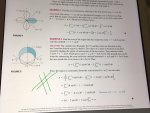I don’t understand why this is symmetric.
EXAMPLE 2. .Find the area of the region that lies within the circle \(\displaystyle r\, =\, 3\, \sin(\theta)\) and outside the cardioid \(\displaystyle r\, =\, 1\, +\, \sin(\theta).\)
SOLUTION. .The cardioid (see Example 10.3.7) and the circle are sketched in Figure 5, and the desired region is shaded. The values of a and b in Formula 4 are determined by find the points of intersection of the two curves. They intersect when \(\displaystyle 3\, \sin(\theta)\, =\, 1\, +\, \sin(\theta),\) which gives:
. . . . .\(\displaystyle \sin(\theta)\, =\, \dfrac{1}{2}\)
...so:
. . . . .\(\displaystyle \theta\, =\, \dfrac{\pi}{6},\, \dfrac{5\pi}{6}\)
The desired area can be found by subtracting the area inside the cardioid between these intersection points from the area inside the circle between the same intersection points. Thus:
. . . . .\(\displaystyle \displaystyle A\, =\, \frac{1}{2}\, \int_{\pi/6}^{5\pi/6}\, \big(3\, \sin(\theta)\big)^2\, d\theta\, -\, \frac{1}{2}\, \int_{\pi/6}^{5\pi/6}\, \big(1\, +\, \sin(\theta)\big)^2\, d\theta\)
Since the region is symmetric about the vertical axis \(\displaystyle \theta\, =\, \frac{\pi}{2},\), we can write:
. . . . .\(\displaystyle \displaystyle A\, =\, 2\, \bigg[\, \frac{1}{2}\, \int_{\pi/6}^{\pi/2}\, 9\, \sin^2(\theta)\, d\theta\, -\, \frac{1}{2}\, \int_{\pi/6}^{\pi/2}\, \left(1\, +\, 2\, \sin(\theta)\, +\, \sin^2(\theta)\right)\, d\theta \, \bigg]\)
. . . . . . . . . .\(\displaystyle \displaystyle =\, \int_{\pi/6}^{\pi/2}\, \left(8\, \sin^2(\theta)\, -\, 1\, -\, 2\, \sin(\theta)\right)\, d\theta\)
. . . . . . . . . .\(\displaystyle \displaystyle =\, \int_{\pi/6}^{\pi/2}\, \big(3\, -\, 4\, \cos(2\, \theta)\, -\, 2\, \sin(\theta)\big)\, d\theta\)
. . . . . . . . . .\(\displaystyle =\, 3\,\theta\, -\, 2\, \sin(2\, \theta)\, +\, 2\, \cos(\theta)\bigg]_{\pi/6}^{\pi/2}\, =\, \pi\)
Any explanation please?
EXAMPLE 2. .Find the area of the region that lies within the circle \(\displaystyle r\, =\, 3\, \sin(\theta)\) and outside the cardioid \(\displaystyle r\, =\, 1\, +\, \sin(\theta).\)
SOLUTION. .The cardioid (see Example 10.3.7) and the circle are sketched in Figure 5, and the desired region is shaded. The values of a and b in Formula 4 are determined by find the points of intersection of the two curves. They intersect when \(\displaystyle 3\, \sin(\theta)\, =\, 1\, +\, \sin(\theta),\) which gives:
. . . . .\(\displaystyle \sin(\theta)\, =\, \dfrac{1}{2}\)
...so:
. . . . .\(\displaystyle \theta\, =\, \dfrac{\pi}{6},\, \dfrac{5\pi}{6}\)
The desired area can be found by subtracting the area inside the cardioid between these intersection points from the area inside the circle between the same intersection points. Thus:
. . . . .\(\displaystyle \displaystyle A\, =\, \frac{1}{2}\, \int_{\pi/6}^{5\pi/6}\, \big(3\, \sin(\theta)\big)^2\, d\theta\, -\, \frac{1}{2}\, \int_{\pi/6}^{5\pi/6}\, \big(1\, +\, \sin(\theta)\big)^2\, d\theta\)
Since the region is symmetric about the vertical axis \(\displaystyle \theta\, =\, \frac{\pi}{2},\), we can write:
. . . . .\(\displaystyle \displaystyle A\, =\, 2\, \bigg[\, \frac{1}{2}\, \int_{\pi/6}^{\pi/2}\, 9\, \sin^2(\theta)\, d\theta\, -\, \frac{1}{2}\, \int_{\pi/6}^{\pi/2}\, \left(1\, +\, 2\, \sin(\theta)\, +\, \sin^2(\theta)\right)\, d\theta \, \bigg]\)
. . . . . . . . . .\(\displaystyle \displaystyle =\, \int_{\pi/6}^{\pi/2}\, \left(8\, \sin^2(\theta)\, -\, 1\, -\, 2\, \sin(\theta)\right)\, d\theta\)
. . . . . . . . . .\(\displaystyle \displaystyle =\, \int_{\pi/6}^{\pi/2}\, \big(3\, -\, 4\, \cos(2\, \theta)\, -\, 2\, \sin(\theta)\big)\, d\theta\)
. . . . . . . . . .\(\displaystyle =\, 3\,\theta\, -\, 2\, \sin(2\, \theta)\, +\, 2\, \cos(\theta)\bigg]_{\pi/6}^{\pi/2}\, =\, \pi\)
Any explanation please?
Attachments
Last edited by a moderator:

